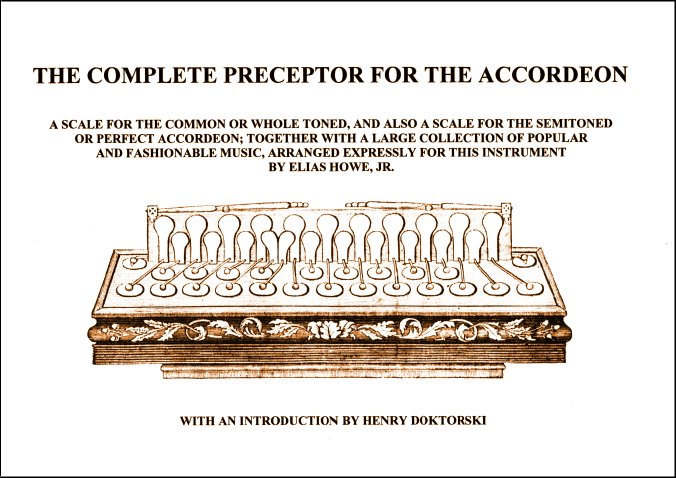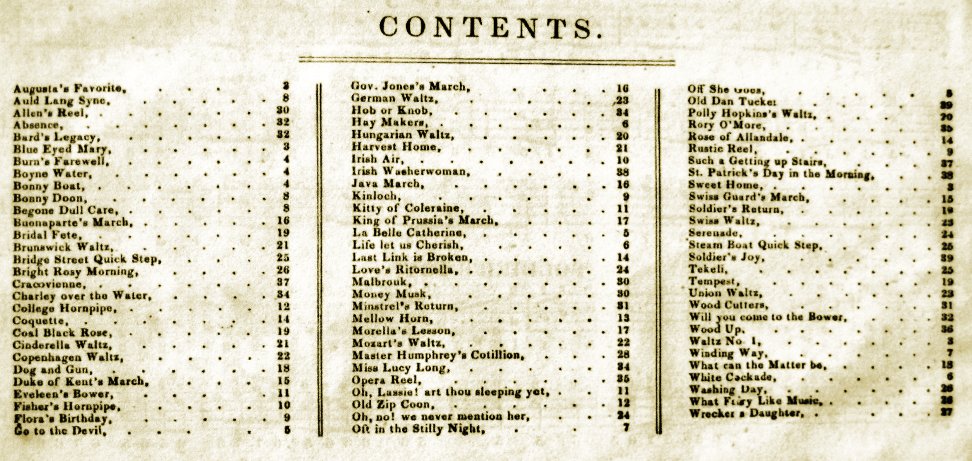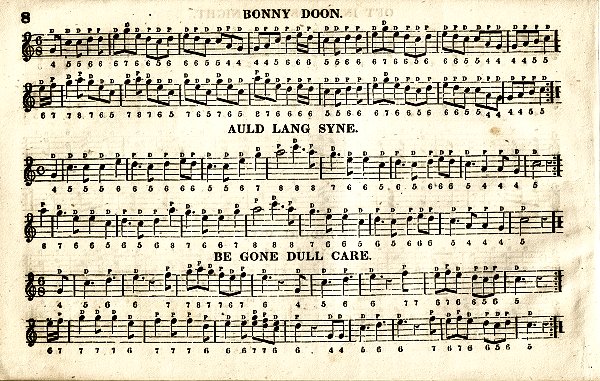The Complete Preceptor for the Accordeon
by Elias Howe, Jr., Introduction by Henry Doktorski

Summary
This book, originally titled, THE COMPLETE PRECEPTOR FOR THE ACCORDEON, CONTAINING A SCALE FOR THE COMMON OR WHOLE TONED, AND ALSO A SCALE FOR THE SEMITONED OR PERFECT ACCORDEON; TOGETHER WITH A LARGE COLLECTION OF POPULAR AND FASHIONABLE MUSIC, ARRANGED EXPRESSLY FOR THIS INSTRUMENT, was written by Elias Howe, Jr. (1820-1895) and originally published in 1843. The book contains:
• A diagram of the scale for the diatonic single-action accordion with a 20 note range with an explanation of the letter and numerical symbols accompanying the staff notation.
• 86 songs written in traditional staff notation for single-line melody in treble clef, as well as a series of numbers and letters which allow those who do not read music to play the pieces.
• The scale for the semi-toned or perfect accordion [also single-action]. This was a nearly-perfectly chromatic instrument with a 37 note range. Also included is an illustration of the semi-toned instrument.
• A contents page which appears at the very end of the book.
Henry explained in the Introduction:
“Howe’s book The Complete Preceptor for the Accordeon is a fascinating relic of an earlier era: it was published by Oliver Ditson in Boston in 1843, only fourteen years after the Austrian piano and organ maker Cyrill Demian (1772-1847) patented the accordion in Vienna on May 23rd, 1829. The illustration of the semi-toned accordion in Howe’s book is detailed and clearly shows the placement of the keys, pallets, valves, bellows and ornamental filigree.
“The choice of tunes presented gives us an indication of the styles of music which the public expected to hear on the accordion. There were the expected European ethnic songs: British, Irish, Russian, German, Hungarian, Danish, Prussian, Swiss, etc., as well as some folk fiddle tunes such as Old Zip Coon.”
The Complete Preceptor for the Accordeon is a priceless treasure from the annals of free-reed history, and will be a truly treasured addition to the library of the discriminating accordion aficionado. This item also available as a PDF file.
Softcover
49 pages
Accurate facsimile of Howe's original book
Measures 8.5 x 6.5 inches
Professional Printing and Binding
Originally Published 1843
Republished with an Introduction by Henry Doktorski in October 2006
Published on Amazon in December 2024

Contents page.
Introduction by Henry Doktorski
Elias Howe, Jr. (1820-1895) was a well-known fiddler, tune collector and music publisher, and the founder of the Boston-based Elias Howe Music Publishing Company. He was a contemporary and possibly a distant relative of the Elias Howe who invented the sewing machine. Elias Howe, Jr. acquired a fiddle as a young boy and soon learned to play. Part of his musical education involved listening to other New England fiddlers and copying down the tunes they played.
Howe eventually acquired a substantial collection of these tunes and managed to get them published in book form in 1840 as The Musician’s Companion. Within a few years Howe had published several other volumes of tune collections and musical instruction, including one forty-page music book for accordion: The Complete Preceptor for the Accordeon, which was published in 1843.
In 1850 he sold his rights to his works to the Oliver Ditson Company at 115 Washington Street in Boston and agreed to desist from publishing music for a period of ten years. Oliver Ditson and C. C. Clapp and Company of 67 Court Street in New York City published the second edition of Howe’s The Complete Preceptor for the Accordeon in 1850. The method sold for fifty cents. Another edition was published in 1851, which implies that the book was so popular that the first two editions sold out.
Elias Howe, Jr. returned to music publishing in 1860 after the term of his agreement with Ditson had expired, and became one of the most prolific music publishers in America. During the Civil War, Howe expanded his activities to include manufacturing drums for Massachusetts regiments. He was offered the position of Director of Bands for the United States Army, and the rank of Lieutenant Colonel by President Lincoln. He chose instead to continue manufacturing drums and fifes and publishing books for marching bands.
The Elias Howe Company served as a full-service music store, selling different types of instruments (specializing in violins, guitars and mandolins), parts for instruments, and method books (including at least two books for the concertina). The company printed a 97-page catalogue for mail order business.
After Howe’s death in 1895 his business continued; managed by his two sons and his daughter. The company eventually closed its doors in the 1930s during the Great Depression.
I discovered this copy (1850 edition) of Howe’s The Complete Preceptor for the Accordeon in the reference shelves of the Music and Art Department of the Carnegie Public Library on Forbes Avenue in Pittsburgh, Pennsylvania. According to the Online Computer Library Center catalog, there are only eight other copies of this book at participating OCLC libraries in the United States.
The book at the Pittsburgh Carnegie Library—which measures nearly ten inches in width and six inches in height—is in remarkable condition, considering the fact that it is more than one and a half centuries old. The book has been rebound, apparently by the library; the original paper cover has been pasted on a sturdy green cardboard cover, but the inside pages were spared of this depravity. I don’t believe that the owner of this book really practiced the tunes; the pages are unwrinkled and unsoiled.
The Complete Preceptor for the Accordeon contains:
° A diagram of the scale for the diatonic single-action accordion with a 20-note range, and an explanation of the letter and numerical symbols accompanying the staff notation (page 2)
° 86 songs written in traditional staff notation for single-voice melody in treble clef, as well as a series of numbers and letters which allow those who do not read music to play the pieces.
° The scale of the semi-toned or perfect accordion (also single-action). This was a nearly-perfectly chromatic instrument with a 37-note range. Also included is an illustration of the semi-toned instrument (page 33).
° A contents page which appears at the very end of the book (page 40).
The Complete Preceptor for the Accordeon is a fascinating relic of an earlier era; Howe’s original book was published in 1843, only fourteen years after the Austrian piano and organ maker Cyrill Demian (1772-1847) patented the accordion in Vienna on May 23rd, 1829. This in itself is a powerful testimony to the phenomenal explosion in popularity of the instrument throughout the world during the mid-19th century.
The illustration of the semi-toned accordion in The Complete Preceptor for the Accordeon is detailed and clearly shows the placement of the keys, pallets, valves, bellows and ornamental filigree. It is significant to note that the instrument Howe wrote for had no left-hand buttons or keys. Only the right hand played the music; the left hand simply pumped the bellows.
The choice of tunes presented in this book gives us an indication of the “popular and fashionable” music with the mid-19th-century American public expected to hear on the accordion. There were the customary European ethnic songs: British, Irish, Russian, German, Hungarian, Danish, Prussian, Swiss, etc., as well as some folk fiddle tunes such as “Old Zip Coon” (today known as “Turkey in the Straw”).
One tune which aroused my curiosity was “Mozart’s Waltz,” but after closer inspection, I decided it must have been written not by the famous 18th-century composer Wolfgang Amadeus Mozart, but probably by the 19th-century folk musician Allan Mozart. It is also possible that the tune was invented by an anonymous folk musician who titled his piece in dedication to one of the two Mozarts.
I recognized many of the tunes, if not the titles. “Augusta’s Favorite” is our modern day “Twinkle, Twinkle, Little Star.” “Sweet Home” is our modern “Home, Sweet Home.” “Absence” is known by today’s Suzuki violin students by the name of “Go Tell Aunt Rhody.” A few songs have familiar titles, “Auld Lang Syne,” “Irish Washerwoman,” and “[O Dear] What Can the Matter Be.”
Certainly The Complete Preceptor for the Accordeon is a priceless treasure from the annals of free-reed history.

Page 8 includes the songs: Bonny Doon, Auld Lang Syne, and Be Gone Dull Care.
Order from Amazon.com at Complete Preceptor for the Accordeon.